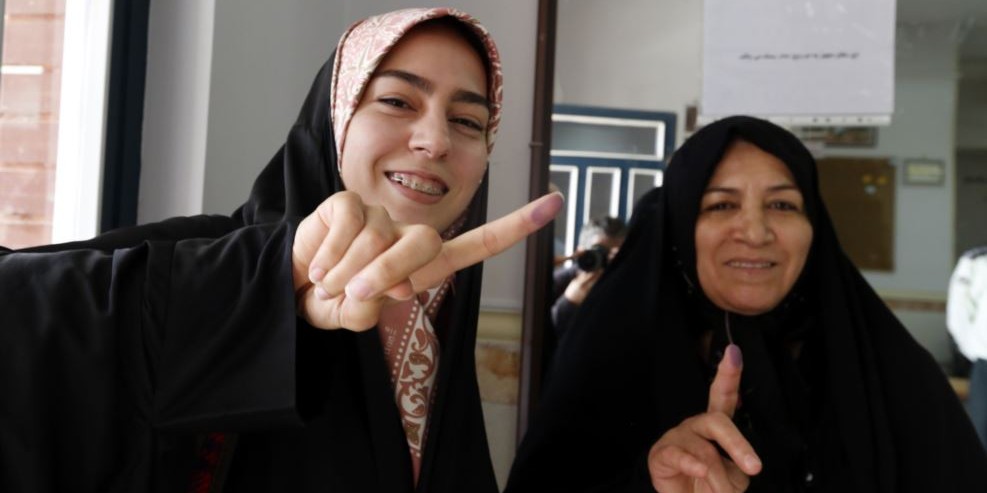PHOTO: Women in Tehran display ink-stained fingers after voting in Friday’s run-off elections for Parliament
As Iranians vote on Friday in run-off elections for about 25% of Parliamentary seats, Radio Free Europe’s Frud Bezhan assesses how the outcome could affect the balance of power in the Islamic Republic:
Iran’s fractious political camps clash on April 29 in runoff votes to finalize the makeup of Parliament, two months after a split result dealt a blow to hard-liners but failed to produce a majority.
There are reasons to watch the voting again this time around, even if the contests make less of an international splash than when reformists and moderates came back in from the political cold in late February.
Nearly one-quarter of Iran’s 290 national legislative seats are at stake in the Friday vote, in which President Hassan Rouhani and his reformist and moderate allies hope to consolidate their recent gains and minimize the power of the conservatives, who lost dozens of seats in the February 26 elections but still hold most of the cards in a number of other, more powerful institutions.
The runoffs won’t redefine power in the Islamic republic because the Parliament lacks influence on key national issues, which ultimately lie under the control of Supreme Leader Ayatollah Ali Khamenei.
Even determining which political camp — reformists and moderates, independents, or hard-liners and conservatives — or combination of camps holds a Parliamentary majority is difficult because Iran lacks rigid party affiliations and some independent candidates are claimed by more than one bloc.
Tilting The Balance?
“After an inconclusive first round, the runoff[s] will determine the final balance of power,” says Ali Vaez, a senior Iran analyst at the International Crisis Group.
In February, conservatives were credited with winning around 112 seats in the 290-seat parliament, the reformist-moderate camp 90, and independents 29 seats, according to a tally by the Reuters news agency.
That showing for the reformist-moderate camp was particularly significant since it has had little representation in the current legislature, which is dominated by conservatives and hard-liners. Reformists and moderates also had to endure election-vetting authorities’ exclusion of hundreds of their candidates.
Reformists boycotted the last parliamentary elections, in 2012, in response to a government crackdown on the opposition that included mass arrests, allegations of torture, and televised trials after the disputed presidential election in 2009.
The last time the reformists and moderates had this much representation in parliament was during reformist President Mohammad Khatami’s first term in office, beginning in 1997.
Sixty-eight seats in small towns scattered around 21 of Iran’s 31 provinces are being contested in the April 29 runoffs. Mohammad Reza Aref, a leader of the reformist-moderate camp, has set a target of at least 40 of those seats to secure an upper hand in the next parliament, although observers have lowered expectations.
“The reformist-moderate camp has a difficult task ahead,” Vaez says. “Turnout, particularly of their constituents, is usually lower in the second round.”
The Uncertainty of Independents
Dozens of candidates who have no clear factional affiliation entered the parliament in the first round, and scores more are in runoffs. “These first-time lawmakers usually join one of the political blocs that form after the new parliament convenes,” Vaez says. “When that happens in May, their choices could tilt the balance of power.”
Both the conservative camp and the reformist-moderate camp will look to absorb as many independents as possible to try to create a majority. The success of independents, however, could also prove a pitfall.
“The independents could split the legislature by creating pragmatist and conservative blocs of equal weight, thus giving rise to a hung Parliament that slows down — rather than facilitates — decision making,” Vaez says.
Multiple Power Centers
One unlikely outcome, a decisive majority for the reformist-moderate camp, could strengthen Rouhani’s hand in his bid to push for mild reform via legislation, along with economic changes, including new laws to encourage foreign investment and the privatization of state industries.
Yet Parliament lacks influence over Iran’s foreign policy and important national issues, with hard-line allies of the supreme leader controlling many key institutions, including the Islamic Revolutionary Guards Corps, the Guardian Council, and the powerful judiciary.
“The Parliament is not going to be a decisive force on its own,” says Scott Lucas, an Iran specialist at Birmingham University in Britain and editor of the EA WorldView website.
During Khatami’s first four-year term in office, both the legislative and executive branches were in reformist hands, yet their reforms were blocked by the Guardian Council, which supervises elections and interprets Iran’s constitution, among other things.
Lucas says he expects no decisive victory for any camp in the runoffs. “It’s precisely because there won’t be a defined majority in parliament that the infighting will continue and you have tension between a whole range of different power centers like the judiciary, intelligence, IRGC, the supreme leader, and the President’s office,” he says.
Record Number of Women MPs
More than a dozen women are competing in runoffs. Combined with the 14 declared female winners in the February vote, that could translate into 20 or so women in parliament. Since the Islamic Revolution of 1979, the highest number of female legislators has been 14.
There are only nine female lawmakers in the current legislature, or a little over 3 percent of the total.
The female candidates, most of them reformists or independents, could possibly give Rouhani more leverage in passing legislation to empower women and loosen the social and political constraints imposed on them by the clerical authorities. Rouhani made issues of gender discrimination part of his platform for office, and he appointed several female Vice Presidents.

